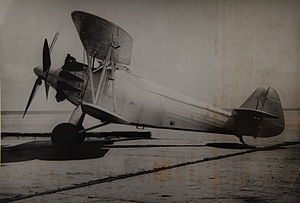Arado Ar 64
| Ar 64 | |
|---|---|
 | |
| General information | |
| Type | Biplanefighter |
| Manufacturer | Arado |
| Primary user | Luftwaffe |
| Number built | 24[1] |
| History | |
| First flight | Spring 1930[1] |
TheArado Ar 64was a single-seatbiplanefighterdesigned and produced by theGermanaircraft manufacturerArado.It was among the first fighters produced whenGermanyabandoned the restrictions of theTreaty of Versaillesandbegan rearming.[1]
The Ar 64 was developed from the earlierArado SD IIandArado SD IIIspecifically to equip the so-called 'display squadrons' of theReichswehr(German armed forces). It was typically powered by aSiemens (Bristol) Jupiter VIair-cooledradial engine,which had a distinctivestreamlineddeflectorshroudaround its cylinders to reducedrag.The Ar 64 was the company's first aircraft to be provisioned withhydraulicbrakes. The prototype made itsmaiden flightin the spring of 1930.
While the aircraft exhibited unfavourable take-off and landing characteristics, as well as structural weaknesses that could led to it breaking up, the Ar 64 emerged as the favourite and received a production contract, unlike the competingHeinkel HD 43.Accordingly, Arado was the first Germany aircraft manufacturer to receive a production order for a fighter. In addition to the Reichswehr, the Ar 64 garnered the attention of theSoviet Union,although no export order was forthcoming. The Ar 64 would be further developed into theAr 65,an improved fighter powered by theBMW VIinline engine and featuring connectedailerons.Both aircraft were built in parallel through to 1936.
Design and development
[edit]During the early to mid 1920s, theGermanaircraft manufacturerAradohad, in conformance with the restrictions on Germany's aviation industry enacted by theTreaty of Versailles,largely focused upon the civil aviation market.[2]However, the company quickly recognised the opportunities available from theReichswehr(German armed forces), particularly during the 1926–1929rearmament programme.One initiative of this programme was the development of militaryprototypesthat could, in the event of conflict breaking out, be promptly put into mass production.[2]Furthermore, the Reichswehr was quietly re-establishing a secret air force under the guise of setting up 'display squadrons'. Despite these ambitions, government funding for aviation was limited, and several of the larger German aircraft manufacturers saw little value in producing prototype military aircraft with seemingly little chance of a production order following.[2]
Arado was the first of Germany's aircraft manufacturers to be awarded a production contract.[2]Their design, designatedAr 64,was a derivative of the earlierArado SD IIandArado SD III,and had been developed to fulfil theReichswehrministerium's (Reich War Ministry) requirement for a successor to theFokker D.XIIIfighter. Visible external differences from its predecessors included its longer fuselage, enlargedrudder,and slightly smaller fin, which gave the aircraft greater manoeuvrability.[2]It was the first Arado-built aircraft to be outfitted withhydraulicbrakes. It was typically powered by aSiemens (Bristol) Jupiter VIair-cooledradial engine,which drove a four-bladed wooden Schwartz propeller.[2]Astreamlineddeflectorshroudaround the engine's cylinders reduceddrag.It was typically armed with a pair of 7.92 mm (0.312 in)MG 17 machine guns.[2]
The prototype performed itsmaiden flightin the spring of 1930.[1]While the aircraft was criticised for its unfavourable take-off and landing characteristics, as well as structural weaknesses that could result in the aircraft breaking up, the Ar 64 was considered to be superior to its principal competitor, theHeinkel HD 43.Accordingly, a production order for 20 Ar 64s was placed in the summer of 1932, while the HD 43 did not proceed beyond the prototype stage.[3][1]This order comprised two different models, the Ar 64D and Ar 64E, which would be the first fighters built in quantity by Germany since the end of theFirst World War.The two models differed slightly, the Ar 64D having a revisedundercarriageand a four-blade propeller while the Ar 64E was equipped with a two-blade propeller attached to a direct-drive version of the Jupiter VI engine.[1]
During the early 1930s, the Ar 64 was subject to international interest; theSoviet Unionwas reportedly quite interested in the aircraft, however, declining relations between the two nations made any order unrealistic.[4]Production did proceed for the Reichswehr; by 1932, a monthly production target of 27 aircraft was set, although it was never achieved. The final aircraft was delivered on 30 April 1936.[3]A total of 19 Ar 64s were assigned to theJagdfliegerschuleatSchleissheimand theJagdstaffelnof theFliegergruppeDoberitz andFliegergruppeDamm.[1]
The Ar 64 would serve as the basis for the improvedAr 65fighter; it differed little in terms of its construction, but benefitted from a longer fuselage, the newly-developedBMW VIinline engine, and the connectedailerons.[5]Production of the Ar 64 and Ar 65 proceeded in parallel through to 1936.[5]
Variants
[edit]Data from:[1]
- Ar 64a
- Prototype,powered by a 395 kW (530 hp)Bristol Jupiter VInine-cylinder radial. First flight in 1930. One built
- Ar 64b
- Only two built, powered by a 477 kW (640 hp)BMW VI6.3 12-cylinderV-typewater-cooled engine. First flight in 1931. Two built.
- Ar 64c
- Powered by a 395 kW (530 hp) Jupiter VI radial, but with minor structural changes. One built.
- Ar 64D
- Production model. Featured redesigned, and enlarged vertical tail surfaces and a revised undercarriage. Powered by a geared Jupiter VI radial. A total of 20 D and E model Ar 64s were built.
- Ar 64E
- Production model. Similar to the 64d but with a direct-drive version of the Jupiter VI radial. A total of 20 D and E model Ar 64s were built.
Operators
[edit]Specifications (Ar 64D)
[edit]Data fromAircraft of the Third Reich[1]
General characteristics
- Crew:one
- Length:8.43 m (27 ft 8 in)
- Wingspan:9.9 m (32 ft 6 in)
- Empty weight:1,210 kg (2,668 lb)
- Max takeoff weight:1,680 kg (3,704 lb)
- Powerplant:1 ×Siemens (Bristol) Jupiter VInine-cylinder air-cooled radial piston engine, 395 kW (530 hp)
- Propellers:4-bladed wooden fixed pitch propeller
Performance
- Maximum speed:250 km/h (160 mph, 130 kn) at 5,000 m (16,404 ft)
Armament
- 2 × 7.92 mm (0.312 in)MG 17 machine guns
See also
[edit]Related lists
References
[edit]Citations
[edit]Bibliography
[edit]- Green, William; Swanborough, Gordon (2002).The Complete Book of Fighters.Salamander Books.
- Green, William (2010).Aircraft of the Third Reich(1st ed.). London, UK: Aerospace Publishing Limited. p. 23.ISBN978-1-900732-06-2.
- Kranzhoff, Jörg Armin (1997).Arado, History of an Aircraft Company.Atglen, Pennsylvania, US: Schiffer Books.ISBN0-7643-0293-0.
